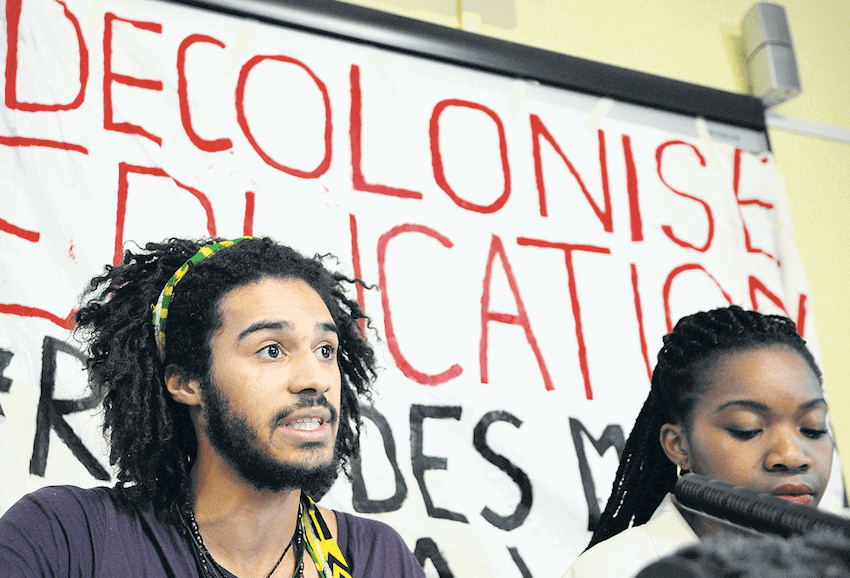IN MARCH 2018, Rufaro Chisango, a black student at Nottingham Trent University, tweeted a video of students chanting “we hate the blacks” outside of her dorm.
This shockingly racist abuse quite rightly drew widespread condemnation. Whenever someone does something explicitly racist, it’s often framed as an isolated incident.
This doesn’t just misrepresent the experiences of black, Asian and minority ethnic (BAME) students who face racism in many forms on a daily basis, it obscures the structural and institutional nature of racism.
It’s important and necessary to reprimand the offending students. But that’s the easy part. To make meaningful change, interventions need to go to the roots of the problem.
Although the number of BAME students attending university is increasing far quicker than white students, black students report lower levels of satisfaction than other racial groups.
They are also more likely to “drop out” and have lower attainment levels than their white peers – even when they enter university with the same grades.

The outcomes and experiences of black students in academia are symptomatic of institutions where white power structures have long dominated.
This makes black students and staff seem out of place and lays the ground for experiences such as Chisango’s.
Over the past few years, student-led campaigns have gone to great pains to point out the mechanisms that maintain the whiteness of higher education.
Perhaps those of us committed to change should listen. The student-led Why Is My Curriculum White? campaign has challenged the white and Euro-centric nature of the curricula in higher education.
One interviewee for the campaign recalled an undergraduate modern history course which covered the topic of empire over a week, looking at the economic competition between European countries, with all of her readings reportedly written by white academics.
She is not alone.
In a 2011 report conducted by the NUS, almost half of black students noted a lack of diversity in their curriculum.
Overwhelmingly, white, male canons are too often the norm in universities, making it seem like intellectual thought is the preserve of white people. Blackness, then, appears not to belong in universities.
PROBLEMS
In the Why Isn’t My Professor Black? campaign, students have drawn our attention to the lack of black professors – and particularly black women professors – and the problems that arise from such under-representation.
Only 1.19 per cent of British staff on academic contracts are black – far less than the proportion of black people in the broader population, which is 3.3 per cent.
The whiteness of the teaching staff reinforces the whiteness of the curricula, which both work to reinforce the association between whiteness and intellect.
All this contributes to the conditions that make racism possible in higher education.
Student campaigns have also brought attention to some of the ways that the myth of white intellectual superiority is perpetuated on campuses worldwide.
#RhodesMustFall campaigners at Oxford University highlighted Cecil Rhodes’ role in histories of racism, colonialism and genocide.
In so doing, those students have shown that their institution simply does not treat racism and colonialism with the seriousness it deserves.
As those campaigners called for a more diverse curriculum and greater BAME representation in the teaching force, there was a clear sense that these different issues were interlinked, and acted to reinforce the university as a space for white people – but not for people of colour.
The I, too, am campaign started at Harvard in 2017, before quickly spreading to UK campuses – most notably Oxford.
DEROGATORY
Holding up boards that noted the derogatory slights and snubs – known as “microaggressions” – faced by BAME students on a daily basis, the campaigners sought to highlight that “in their daily encounters at Oxford, students of colour are made to feel different and ‘othered’ from the Oxford community”.
These microaggressions occur partly as a consequence of the whiteness that characterises higher education institutions – and, in turn, they act to reaffirm those conditions.
Many students of colour are acutely aware of these cycles, which is why they demand that discussions about race should be taken seriously, and that meaningful changes should occur.
By looking again at the campaigns led by students of colour over the past few years, we can begin to see more clearly the institutional conditions that give rise to abhorrent racist incidents.
To meaningfully tackle racism in higher education, we must listen when students point out how universities create conditions where black students are seen as being out of place.
Dr Remi Joseph-Salisbury is Presidential Fellow in Ethnicity and Inequalities at the University of Manchester. This article originally appeared in The Conversation.
This article appears in the January edition of The Voice newspaper – out now. Download your copy of the issue here.


Comments Form